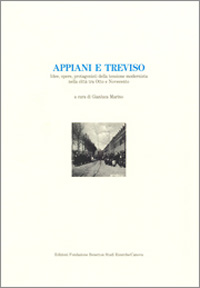
Appiani e Treviso
Idee, opere, protagonisti della tensione modernista nella città tra Otto e Novecento
edited by Gianluca Marino
Fondazione Benetton Studi Ricerche-Canova
Treviso 2003
X-170 pages
40 illustrations in colour and 91 black and white
cover price 25 euros
ISBN 88-8409-093-8
(Memorie, 8)
[Appiani e Treviso. Ideas, achievements and leading figures in the modernising of the city between the XIX and XX centuries]
In the years covering the end of the XIX and the beginning of the XX centuries, the city and province of Treviso experienced a process of modernist transformation. This development was promoted by a small group of enlightened entrepreneurs influenced by the current of radical innovation in industry and crafts then flowing through Europe, with experimental exploration of new forms of expression in all fields.
The group had a strong sense of its economic, social and cultural mission («pursuit of our own interests is in the interest of the city») and excellent relations with the authorities (see the correspondence between Graziano Appiani and Luigi Luzzatti); it made its presence felt in all administrative, professional and political fields and was open to dialogue with figures from other political and cultural backgrounds (including Cosimo Canovetti, Antonio Pedrini, Giovanni Masera and Giuseppe Sommaruga); it also showed a remarkable ability to devise programmes, projects, plans and the administrative tools to implement them (see the rapid rise of «Il Risveglio Trevisano» by Gian Giacomo Felissent).
Underlying everything was the idea that technical progress in itself, for some, offers fertile ground for enterprise and at the same time a source of relief and support for substantial strata of society, bringing improvements to their standards of living, in the workplace, for their physical health and even for their psychic wellbeing (these are the years that saw the building of the psychiatric hospital of Sant’Artemio in Treviso.
This volume is an attempt to provide a composite account of how, when and where this crucial phase in the contemporary history of Treviso took place, of the personalities that took part in the wide-ranging debate and of the conflict of interests it unleashed. The critical figure at this turning point was Graziano Appiani, with his modernizing energy, his enlightened politics, his actions (achieved results or proposals): welfare housing and the Eden Theatre, the attempts to move the station in order to give the city a more spacious forma urbis, the stimulation of ideas for the overpass, the telecommunications, street lighting and public transport systems and a programme to develop the railway system (passengers and goods) for the benefit of the whole province. What emerged gave new identity to the city and the region for the first time since the end of the Venetian state.
But with the approach of the storm-clouds of war and for other reasons the political schemes of Appiani and this small elite of entrepreneurs quickly fell into crisis. The group lost its focus and even the affairs and involvement of individuals soon came to an end.
Contents
Prefazione, di Domenico Luciani, VII
Idee
Gianluca Marino, La tensione modernista della città, 3
Livio Vanzetto, L’industriale Appiani nella Treviso del primo Novecento, 27
Livio Fantina, Il giardino del costruttore. Continuità e discontinuità con i modelli culturali della tradizione trevigiana, 34
Opere
Gianluca Marino, Luce e telefono. Appiani e lo sviluppo delle infrastrutture, 53
Umberto Zandigiacomi, Il piano Giuriati-Milani per lo spostamento della stazione ferroviaria, 63
Teresa Marson, La Treviso-Ostiglia. Un dibattito tra le nuove istituzioni repubblicane, 71
Andrea Bellieni, La forma urbis tra Otto e Novecento, 79
Protagonisti
Graziano Appiani (Milano 1850-Treviso 1920), 91
Luigi Luzzatti (Venezia 1841-Roma 1927), 96
Gregorio Gregorj (Treviso 1853-Treviso 1931), 96
Vincenzo Gregorj (1851-1914), 99
Gian Giacomo Felissent (Treviso 1857-Milano 1912), 100
Cosimo Canovetti (Firenze 1853-Gardone Riviera 1932), 102
«Il Risveglio Trevisano», di CAROLINA PUPO, 104
Milano e Treviso: influenze dalla “capitale morale”, di ALESSANDRA MARIN, 109
Appendice
Appiani e Treviso. Sequenza iconografica, a cura di TONI BASSO, 119
Il carteggio Appiani-Luzzatti. Documenti inediti di un’amicizia nota, 132
Notizie sul Manicomio di Treviso, 148
Bibliografia citata, 151
Tavola delle abbreviazioni, 157
Referenze sulle illustrazioni, 157
Indice analitico, 159
